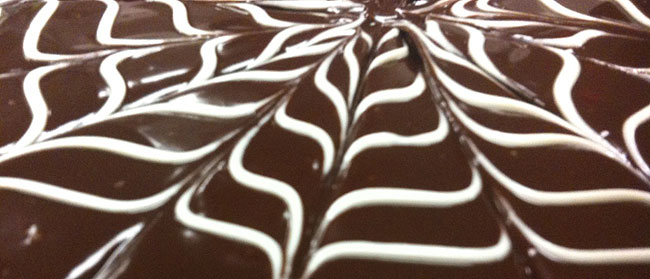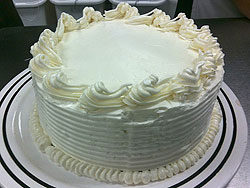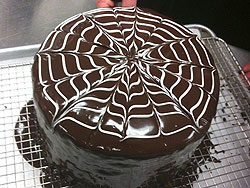Cakes Week Two and Three
Weeks two and three covering cakes consisted of only one main lecture and a lot of time spent on skills for cutting and decorating cakes in the kitchen. I’ve combined the two weeks into one post for that reason.
We covered four types of icings. Traditional American Buttercream is a mixture of sugar, shortening or butter, and milk that is combined with a paddle attachment. This type of frosting is heavy and does not pipe well. When using shortening rather than butter it leaves a film in the mouth. This is a result of butter melting at a lower temperature than shortening, which does not melt in the mouth.
Swiss buttercream is the easiest to make of the two traditional buttercreams. To make Swiss buttercream egg whites and sugar are heated over a bain-marie (water bath) until they have reached 140° to 160°. The higher the temperature the harder the frosting will be. The eggs whites and sugar are then whipped on high speed until cool, which creates a swiss meringue. Butter is then added a little at a time and finally any flavorings.
The more stable of the buttercreams and the most difficult to make is Italian buttercream. Sugar and water are brought to a boil and poured into whipped egg whites. The mixture is whipped until the meringue has cooled and then butter is added and flavorings. When poring the boiled sugar and water into the egg whites one must be careful as to the placement of the poor so it does not splatter all over. Both Italian and Swiss buttercream will last up to four days at room temperature.
When making a cream cheese based frosting butter and cream cheese are mixed with the paddle attachment at a low speed. When the butter and cream cheese are thoughtfully combined melted chocolate or flavorings are added followed by powdered sugar. The higher the speed used on the mixer the more air is added which changes the color to a lighter color and airy texture, usually this is not what one wants with this type of frosting.
In the kitchen, we covered using a cake stand to decorate and slice a cake into layers. We also learned the different methods of piping. I’ll demonstrate some of this in future postings on cakes.
Heres what we made the last two week:

 Chiffon Sponge with Buttercream and filled with pastry cream
Chiffon Sponge with Buttercream and filled with pastry cream Jeff’s Chocolate Birthday Cake with Ganache and cream cheese frosting filling
Jeff’s Chocolate Birthday Cake with Ganache and cream cheese frosting filling
1 Comment
i love the cakes <3